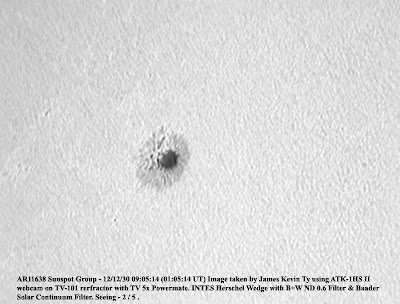Monday, December 31, 2012
New Year's First Astro Image - Waning Gibbous Moon
I couldn't resist taking an image of the Waning Gibbous Moon to start my 2013 astro imaging session. Hope this will bring good luck and more clear skies for 2013! Happy New Year to all!!!
Sunday, December 30, 2012
Solar Imaging Session - December 30, 2012
The sky this morning is partly clear but seeing condition is good.There is a nice solar eruption activity in the NE limb that is worth viewing! Although not that big and prominent, it was worth the wait for me to capture it. AR11638 Sunspot Group continues to grow in size and is worth monitoring the next few days if it will grow larger a bit more.
Numerous group of eruptive prominences are scattered around the solar disk. I was able to image AR11638 Sunspot Group in white light.
Saturday, December 29, 2012
Solar Imaging Session - December 29, 2012
The sky condition this morning is even worst than yesterday's poor seeing condition :( Once again, lots of cloud cover hampered my imaging session this morning. AR11638 Sunspot Group is starting to exit Wilson's Effect as it continue to moved westward across the solar disk. Today's images are also poor and also resembled what I was able to observe yesterday results. :( I hope to get better luck tomorrow morning so I can get a better high resolution shot of this big group. Numerous groups of sunspots and dark filaments are scattered around the Sun's disk.
Solar Imaging Session - December 28, 2012
The sky this morning was partly clear but seeing is not very good. Add to the frustration are pesky clouds covering the Sun almost all the time :( Nevertheless, this didn't stop me from doing solar work but of course under poor image quality.
New AR11638 Sunspot Group is large solitary group at the edge of NE limb, AR11635 Sunspot Group is about to exit the NW limb. Lots of moderate sized eruptive prominence around the Sun's limb but are not that spectacular.
As I was about to image in white light, clouds cover becomes thicker and thicker and I was able to image only AR11638 Sunspot group only and under poor seeing condition as well :(
Monday, December 24, 2012
Solar Imaging Session - December 25, 2012
The sky this morning is very hazy and seeing is poor :( Nevertheless, I proceeded to observe the Sun as it's been more than 3 weeks the last time I did solar imaging because of busy skeds :(
The Sun has 2 sunspot group visible on the disk with AR11635 Sunspot Group being the biggest group. Despite its size, there are no large umbral structure that will highlight this group except for a few smaller main groups found inside the group. AR11634 and AR11633 Sunspot Groups are nearing the SW limb and will probably be exiting in 2-3 days more or less.
In Ha wavelength, not much activity except for some moderate flaring activity that is visible in AR11635 Sunspot Group. 2 large long dark filaments can be seen in the SW quadrant. Another possible new active region is developing in the NE limb as well.
In white light, I was testing the Baader Solar Continuum narrow band Filter to replace my broadband #56 green filter in the hope of taming my seeing condition here in my place. Initial test result proves promising as despite the bad seeing condition, I can see better contrast on the granulation in the solar surface. Sunspot contrast is also enhanced a bit. I wasn't able to do higher magnification shot of AR11635 Sunspot Group because of the bad seeing so had to settle for the double stacked 2x barlow lens which shows slightly better image. Not that good but is fair enough IMHO.
I hope to do further testing of the new filter in the days to come and hope for better seeing condition as well............
Tuesday, December 4, 2012
Solar Imaging Session - December 4, 2012
The sky this morning is partly cloudy and very hazy. I nevertheless proceeded with my imaging session despite the condition as I was hoping to get another closeup shot of the AR11623 Sunspot Group. After taking a few shots of the Sun in Ha wavelength, clouds get even worst so I wasn't able to image in white light but I was able to see AR11623 and AR11625 Sunspot Groups visually and i notice it had shrunk in size a little bit compare to yesterday before getting clouded out totally :( Overall, solar activity is quite low.
Sunday, December 2, 2012
Solar Imaging Session - December 3, 2012 (Huge NE Eruptive Prominence)
The sky this morning is clear and seeing is also good. I was finally able to do solar imaging again after another long hibernation because of provincial work load and trip. It was hard to reorient myself again on the Sun and I had to check SOHO webpage to update myself on the visible active regions once again :) Anyway, the Sun shows 3 sunspot group this morning with AR11623 showing a nice umbral and penumbral structure and a joy to both view and image through white light wavelength. In Ha wavelength, AR11623 and AR11625 Sunspot Groups has tone down in activity compared to its higher activity past few days :(
But the Ha wavelength won't let the white light wavelength dominate its beauty by showing off a beautiful huge eruptive prominence in the NE limb :)
Saturday, December 1, 2012
November 28-29, 2012 Penumbral Lunar Eclipse
While I was in Legaspi City, I was invited by former ALPer Rome Candaza to be a guest lecturer on E-Day. Since I will still be in my Bicol work trip on November 28th, I brought along my portable Canon EOS 500D DSLR with Canon EF 100-400mm f/4.5-5.6 IS L lens to document and image the eclipse after my lecture on chasing eclipses.
The sky was ok the whole evening except for some patchy clouds which break up every time I'm about to image the eclipse:) So with luck on my side, I was able to image a complete 15 mins interval shot of the entire eclipse from 8:00pm to 1:00am :) Since this is just a penumbral lunar eclipse, I made sure my exposure is consistent throughout the entire eclipse so I can get a good exposure sequence of the penumbra all throughout the 94% the Moon is immersed in the Earth light shadow :)
Polarie Star Tracker - First Glimpse and Preview
The Vixen Polarie Star Tracker is the ultimate highly portable star tracker that one can own and setup in less than 5 minutes to get started in wide field to medium telephoto astrophotography. Relatively very light for about 700 gms which is more or less the weight of consumer DSLR body. Its size is also a joy to hold in the palm of your hands as it is about 4" x 6" x 2" in dimension! It can carry a payload of around 2.5kgs but later Vixen statement indicates it can carry up to 3.5 kgs might be on the upper limits of its maximum payload weight.
The Polarie unit has a built in polar bore scope for one to get a rough alignment to Polaris and an altitude meter (inclinometer) as well as compass for easy basic polar alignment for wide field astroimaging. For use of a 100mm-200mm lens, an optional polarscope is highly recommended to use. It runs on 2 pcs of AA batteries which can run more or less around 4 hours if alkaline battery is used. Rechargeable NiMH battery can also be used as well as an optional USB mini B plug type battery pack. Another good feature of the Polarie is that it has 4 tracking rates for you to use- Sidereal, Solar, Lunar, 1/2 Sidereal are available on the unit. The 1/2 sidereal rate is very good for use in doing nightscsape time lapse photography :)
The basic Polarie unit has no ball head included in the package but if you buy the Polarie Set with Velbon M-178V tripod, 2 ballheads are included with the package.
If you are interested to buy the Polarie unit or set, please PM me or text me through +639178559863 or email me at jkty@astroleaguephils.org . Serious buyers only please.
More images can be viewed at https://www.facebook.com/media/set/?set=a.10151182147663005.467369.572763004&type=1
Subscribe to:
Comments (Atom)









































